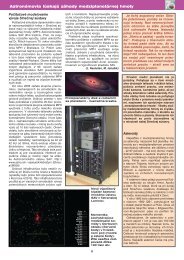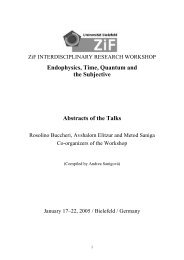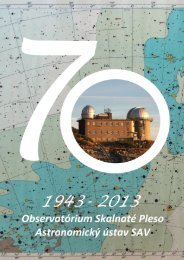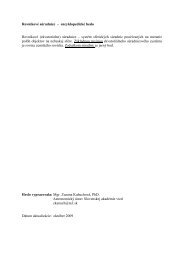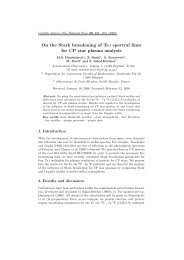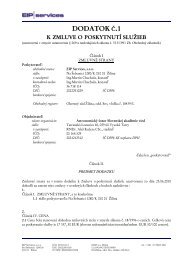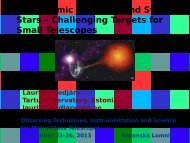Origin and evolution of the black hole binary XTE J1118+480
Origin and evolution of the black hole binary XTE J1118+480
Origin and evolution of the black hole binary XTE J1118+480
You also want an ePaper? Increase the reach of your titles
YUMPU automatically turns print PDFs into web optimized ePapers that Google loves.
<strong>Origin</strong> <strong>and</strong> <strong>evolution</strong> <strong>of</strong> <strong>the</strong> <strong>black</strong><br />
<strong>hole</strong> <strong>binary</strong> <strong>XTE</strong> <strong>J1118+480</strong><br />
Jonay Isaí González Hernández<br />
Instituto de Astr<strong>of</strong>ísica de Canarias (IAC)<br />
In collaboration with:<br />
Rafael Rebolo & Jorge Casares<br />
(Instituto de Astr<strong>of</strong>ísica de Canarias)
HighResolution Spectra:<br />
Chemical analysis <strong>and</strong> refined orbital parameters<br />
BH-LMXBs INSTRUMENT REFERENCES<br />
A0620-00 8m-VLT/UVES<br />
R~43,000<br />
Nova Sco 94 10m-KeckI/HIRES<br />
8m-VLT/UVES<br />
<strong>XTE</strong><strong>J1118+480</strong> 10m-KeckII/ESI<br />
R~6,000<br />
V404 Cygni 10m-KeckI/HIRES<br />
R~45,000<br />
González Hernández et al. (2004,<br />
2010)<br />
Israelian et al. (1999)<br />
González Hernández et al.<br />
(2008a)<br />
González Hernández et al. (2006,<br />
2008b)<br />
González Hernández et al.<br />
(2011a)<br />
NS-LMXBs INSTRUMENT REFERENCES<br />
CEN X-4 8m-VLT/UVES<br />
R~43,000<br />
Cygnus X-2 4.2m-WHT/UES<br />
R~30,000<br />
González Hernández et al. (2005)<br />
Casares et al. (2007)<br />
Casares et al. (2010)
<strong>XTE</strong> <strong>J1118+480</strong><br />
X-ray <strong>binary</strong> with:<br />
-Black <strong>hole</strong> <strong>of</strong> ~ 8 M Sun<br />
-Galactic latitude ~ 62º<br />
- Height over <strong>the</strong><br />
Galactic plane: 1.6 kpc<br />
-Galactic Velocities<br />
(U, V, W)= (-105,-98,-21)<br />
Kinematics <strong>of</strong> <strong>XTE</strong> <strong>J1118+480</strong><br />
Mirabel et al. (2001)
Chemical<br />
abundances<br />
<strong>XTE</strong> <strong>J1118+480</strong><br />
Mg<br />
3<br />
Ca<br />
Al<br />
González Hernández et al. (2006) KeckII/ESI spectra
<strong>XTE</strong> <strong>J1118+480</strong><br />
However, <strong>the</strong> high metallicity <strong>of</strong> <strong>the</strong> secondary star:<br />
[Fe/H] ~ +0.2 dex (~2 times more metals than in <strong>the</strong> sun)<br />
- The <strong>black</strong> <strong>hole</strong> problably formed in a supernova or<br />
hypernova explosion that lauched <strong>the</strong> system into its<br />
present orbit from <strong>the</strong> formation region in <strong>the</strong> Galactic<br />
thin disc (Galactic plane)<br />
- A comparison <strong>of</strong> <strong>the</strong> chemical abundances <strong>of</strong> <strong>the</strong><br />
secondary star with supernova <strong>and</strong> hypernova models <strong>of</strong><br />
different metallicities probably confirms this conclusion<br />
González Hernández et al. (2006, 2008b)<br />
-This implies a lower limit to <strong>the</strong> kinematic age ~ 11 Myr<br />
implying an upper-limit to <strong>the</strong> asymptotic AdS curvature<br />
radius <strong>of</strong> L < 80 �m (Psaltis 2007)
<strong>XTE</strong> <strong>J1118+480</strong><br />
KeckII/ESI radial velocity curve from 74 spectra<br />
González Hernández et al. (2008b)<br />
one night in<br />
2004<br />
R~ 6,000
Refined orbital parameters<br />
i = 68 o +- 2 o (Gelino et al. 2006)<br />
Porb = 0.1699339 ��� 0.0000002 days (Torres et al. 2004)<br />
- vsini = 100 +3<br />
-11 km/s<br />
- k 2 = 708.8 +- 1.4 km/s<br />
- q = M 2 / M BH = 0.027+- 0.009<br />
- f(M) = 6.27 +- 0.04 M SUN<br />
- M BH = 8.30 +0.28<br />
-0.14 M SUN<br />
- M 2 = 0.22 +- 0.07 M SUN<br />
- a c = 2.63 +- 0.03 R SUN<br />
Secondary<br />
star<br />
Hot spot<br />
Accretion<br />
disc<br />
Gas<br />
stream<br />
Compact<br />
object<br />
González Hernández et al. (2008b, 2011a)
Angular momentum losses: <strong>XTE</strong> <strong>J1118+480</strong><br />
1. Magnetic Braking:<br />
If � =0 (maximum strength)<br />
<strong>and</strong> j w = 1 (specific angular momentum lost by <strong>the</strong><br />
mass loss from <strong>the</strong> system)<br />
Then, (dP/dt) MB = -0.14 ms/yr<br />
2. Mass loss<br />
��= 0 (all <strong>the</strong> mass lost by <strong>the</strong> companion is lost)<br />
j w = 1<br />
Then, (dP/dt) MB = -0.8 ms/yr<br />
3. Gravitational radiation:<br />
(dP/dt) GR = -0.01 ms/yr<br />
4. Relativistic Jets: (dJ/dt) JETS / (dJ/dt) MB = 0.001
Relativistic precession<br />
- Usually we assume e=0<br />
- If we leave <strong>the</strong> eccentricity as free parameter<br />
e= 0.0034 +- 0.0037 (consistent with zero)<br />
- Periastron precession due to <strong>the</strong> General<br />
Relativity :<br />
1. Secular precession period ~ 23 yr<br />
2. Apparent orbital period change :<br />
(dP/dt) precession ~ -0.5 +- 0.5 ms/yr
<strong>XTE</strong> <strong>J1118+480</strong><br />
10.4m-GTC/OSIRIS radial velocity curve from 27 spectra<br />
González Hernández et al. (2011b, in preparation)<br />
first night<br />
January 2011<br />
R~ 2,500<br />
We have two<br />
additional<br />
nights:<br />
data not<br />
processed
<strong>XTE</strong> <strong>J1118+480</strong><br />
- These data can provide<br />
3 points <strong>of</strong> T 0<br />
times at <strong>the</strong> inferior<br />
conjunction <strong>of</strong> <strong>the</strong><br />
secondary star<br />
- The preliminary analysis<br />
points to a negative period<br />
derivative<br />
(dP/dt) < 0<br />
- This will set a tighter<br />
upper-bound in <strong>the</strong><br />
parameter L<br />
Johannsen et al. (2009)
<strong>Origin</strong> <strong>and</strong> <strong>evolution</strong> <strong>of</strong> <strong>the</strong> <strong>black</strong><br />
<strong>hole</strong> <strong>binary</strong> <strong>XTE</strong> <strong>J1118+480</strong><br />
Jonay Isaí González Hernández<br />
Instituto de Astr<strong>of</strong>ísica de Canarias<br />
In collaboration with:<br />
Rafael Rebolo & Jorge Casares<br />
(Instituto de Astr<strong>of</strong>ísica de Canarias)




